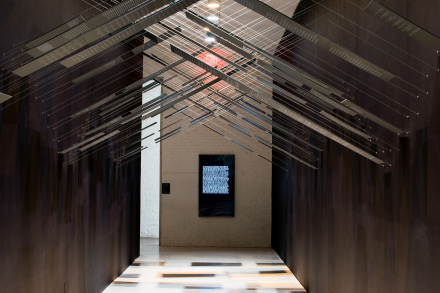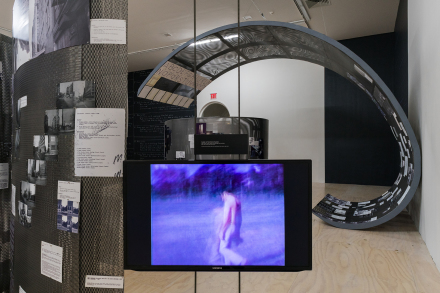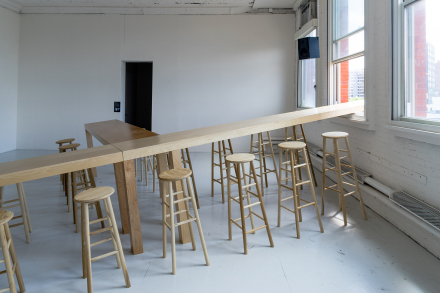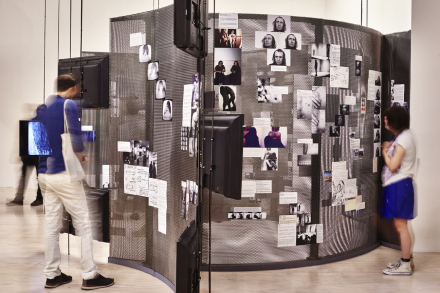
Vito Acconci, WHERE WE ARE NOW (WHO ARE WE ANYWAY?), 1976 (Installation View)
Continuing a consideration of its nearly half-century long history in New York City, MoMA PS1 is celebrating its fortieth anniversary with an exhibition dedicated to the early career of artist Vito Acconci, a pioneer of body and performance art in the United States during the 1960’s and 70’s that drove forward new concepts and perceptions of art practice while PS1 was similarly expanding the concept of the exhibition space. WHERE WE ARE NOW (WHO ARE WE ANYWAY?), 1976 focuses on Acconci’s works from the late ‘60s and early ‘70s—the years that proceeded the opening of PS1 as an experimental, non-profit art center under the guidance of Alanna Heiss.

Vito Acconci, WHERE WE ARE NOW (WHO ARE WE ANYWAY?), 1976 (Installation View)
The traumatic results of the Vietnam War on American politics saw equally resonant impacts on the era’s art scene and artists, as early interest in the body gave way to new explorations of performance and spatial relations guided by the artist in real-time. Amid political and social turmoil, Acconci’s work turned the public’s attention to the concept of mystery, as well as the limits affixed to the human body by both its physical bounds and social convention. The artist experimented with unfolding actions drawing on subliminal tensions and concepts through performances in which his body remained the key medium. Highly politicized through the media’s documentation of dying soldiers and war victims, the body provided Acconci with a vast territory for experimentation and critical occupation.

Vito Acconci, WHERE WE ARE NOW (WHO ARE WE ANYWAY?), 1976 (Installation View)
The repetitious and distorted techniques he employed in his performances derived from his background in writing, for which the Bronx-born artist attended University of Iowa’s renowned MFA writing program. His obsessive and multifaceted utilization of words in his poems, which often paralleled his performances, or actions, stemmed from everyday life and its peculiarities. Acts that seem familiar, such as pulling hair, drinking water or looking in the mirror are transformed into unfamiliar rituals upon his reenactments and slavish repetitions, while the distinctions between the bizarre, the perverse, and the mediocre become loose.

Vito Acconci, WHERE WE ARE NOW (WHO ARE WE ANYWAY?), 1976 (Installation View)
Decades later, Acconci’s close-ups, zoom-outs and rapid gestures still challenge the audience in the museum’s sharp staging of the artist’s influential career. Elsewhere, documentation of performances, such as SEEDBED or Open-Close, continue to intrigue with their provoking plots on carnality, ridiculing firsthand puritanism while confronting a society’s numbness to violence and laceration in the wake of high-powered war and the desensitizing spectacles of capitalism. The exhibition embarks on a challenging arrangement, combining the artist’s early work in poetry and performances within an architectural flow, accompanied by strong archival material.

Vito Acconci, WHERE WE ARE NOW (WHO ARE WE ANYWAY?), 1976 (Installation View)
While each performance is displayed on its own screen, an extensive amount of documentation, photography, and other ephemera equally chronicles Acconci’s oeuvre, spread across the surfaces of industrial structures designed by the artist. The exhibition’s namesake piece, however, resides in a separate room. Stuck between existentialist angst and steadfast optimism, the installation consists of a narrow wooden platform that initially resembles a table surrounded by stools on both ends. Shattering this utilitarian façade is the board’s daring extension outside through the window, transforming it into a diving board to leap outside and into the unknown.

Vito Acconci, WHERE WE ARE NOW (WHO ARE WE ANYWAY?), 1976 (Installation View)
WHERE WE ARE NOW (WHO ARE WE ANYWAY?), 1976 is on view at MoMA PS1 through September 18, 2016.
*Image courtesy of Acconci Studio and MoMA PS1, Photo by Pablo Enriquez, unless noted.
— O.C. Yerebakan
Related Link:
MoMA PS1 [Exhibition Link]



